| Category | Health and Safety |
|---|---|
| Type | Guideline |
| Approved by | Vice-Chancellor, 13 June 2012 |
| Date Guideline Took Effect | 1 July 2012 |
| Last approved revision | |
| Sponsor | Chief Operating Officer |
| Responsible officer | Director, Health, Safety and Wellbeing |
Please note that compliance with University Guidelines is expected in normal circumstances, and any deviation from Guidelines – which should only be in exceptional circumstances – needs to be justifiable.
Purpose
Laboratory Animal Allergy (LAA) is a significant known hazard for those staff, students and visitors involved in the use of laboratory animals (particularly rodents) in their work. While there are various engineering controls in place, this cannot completely eliminate the risk of exposure to animal urine, dander and hair that can cause the allergic response in individuals. The occupational health surveillance process is designed to protect staff and students working with laboratory animals by identifying those individuals at increased risk, the early detection of any allergy changes and prompt treatment and further interventions to reduce exposure.
Organisational scope
All University of Otago animal facilities
Definitions
- LAA
- Laboratory Animal Allergy
- SOP
- Standard Operating Procedure
- HVAC
- Heating, Ventilation and Air Conditioning systems
- PPE
- Personal Protective Equipment
- P2
- Particulate 2 respiratory mask
- PI
- Principal Investigator
Content
1. What is Laboratory Animal Allergy (LAA)?
Laboratory animal allergy (LAA) is an inappropriate immune response to otherwise harmless proteins (allergens) in the urine, saliva, fur, and skin cells of laboratory animals such as rats and mice. LAA affects 10-50 per cent of individuals who are exposed to these allergens. Symptoms include sneezing, running nose, eye inflammation, skin rash and, most seriously, asthma. In addition to a reduced quality of life for affected individuals, both employees and employers suffer due to absence from work and potentially, job loss. The allergenic proteins implicated in LAA are carried on microscopic dust particles that can remain airborne for considerable periods of time, and, unless contained, can migrate throughout a laboratory or animal facility. They can also be carried around a facility on clothing and hair. Although individuals who work directly with laboratory animals are most at risk of developing LAA, the migratory ability of the allergens means that LAA can also affect susceptible individuals who have no direct contact with animals. Some individuals have a greater chance of developing LAA than others, since risk factors include the amount of daily allergen exposure and the presence of pre-existing allergies. It is not currently known whether there is an acceptable upper limit for levels of laboratory animal allergens; the aim of LAA management must therefore be to reduce the levels to as low as possible.
2. Guidelines for prevention of LAA
The Health and Safety in Employment Act (1992) and regulations, require the identification of significant hazards, and management of these hazards by the hierarchy of elimination, isolation or minimisation. LAA is considered a significant hazard, and therefore consideration of elimination of exposure to animal allergens is the first step. The University is managing the hazard controls through the required elimination, isolation and minimisation, as explained below.
2.1 Engineering controls – working towards elimination
The primary engineering control to be applied is ventilation and extraction of the animal allergens to reduce the amount of airborne allergens, thereby reducing exposure. The air levels of allergens is also monitored, however, there is no international standard on the minimum safe exposure (workplace exposure standard) for animal allergens.
Room ventilation: the rate of room extraction, delivery of fresh air and downdraft created is designed to remove allergen loading in the air. The ventilation rates are based on international best practice guidelines at 10–15 fresh air changes per hour, with the animal rooms at negative pressure so that allergen laden air is not re-circulated to non-animal areas. The ventilation rates are monitored annually.
Individually ventilated cage systems: exhaust ventilated cages, or individually ventilated cages, remove the air from the cages (the direct source) and vent it straight outside, without re-entering the room. This greatly reduces the air borne allergens. The University of Otago will consider the installation of individually/exhaust ventilated cages as a part of the upgrade process of animal facility areas.
Cage change ventilation: The cage emptying, or dumping, generates large volumes of airborne allergens. To reduce the hazard, cage dumping stations are used with an extraction unit directly behind the waste receptacle. This unit drags the air from around the operator, across the dumping space, and then vents it to the outside away from the breathing zone. It is important that any cage changing is done with a cage dumping station and for the individual to wear a P2 mask.
Unfortunately, engineering controls cannot completely eliminate the source of animal allergens – the animal dander and urine may contact the skin during handling, and manipulation of animals requires close contact. The methods of isolation and minimisation must also be applied through the use of personal protective equipment (PPE), and administration (reducing time with the animals).
2.2 Isolation and minimization: Personal Protective Equipment (PPE)
| Conventional facility with open shoe box caging | ||||
|---|---|---|---|---|
| Task | Head cover | Scrubs/gown/lab coat | Gloves* | P2 mask |
| Entering facility only | √ | √ | √ | √ |
| Handling rodents | √ | √ | √ | √ |
| Changing cages | √ | √ | √ | √ |
| Removing soiled bedding | √ | √ | √ | √ |
| Ventilated Cage Facility (EVC or IVC) | ||||
|---|---|---|---|---|
| Task | Head cover | Scrubs/gown/lab coat | Gloves | P2 mask |
| Entering facility only | √ | |||
| Handling rodents | √ | √ | √ | |
| Changing cages | √ | √ | √ | |
| Removing soiled bedding | √ | √** | √ | |
*Must include a non-latex option
**gloves more resistant to puncture (e.g. nitrile) may be required to reduce the risk of injury/exposure during the handling of soiled bedding.
- To ensure the maximum protection for staff, PPE should be put on before entering the animal rooms and removed on exiting. All used PPE should be disposed of in appropriate receptacles prior to exiting the facility and should not be carried into non-animal areas such as laboratories, offices or public rooms. However, face masks can be reused; and stored in plastic bags between use.
- Risk of splash: where the work has a risk of splashing the face, as cage washing, a face shield or goggles must also be worn.
Minimisation includes the wearing of appropriate PPE to prevent the allergens contacting the skin, or entering the breathing zone.
Consistent use of PPE is essential in preventing/reducing exposure to allergens and these are readily available at the entrance of animal facilities. PPE that prevents skin contact and inhalation of animal allergens helps to reduce personal exposure and risk of sensitization as well as reduces the spread of allergens throughout the facility.
The required PPE for entry into animal facilities with conventional caging is:
- Long–sleeved laboratory coats/gowns/scrubs
- Hair covers/bonnets
- P2 respiratory masks
Where the animal facility has an individually ventilated caging system, the requirements are:
- Long-sleeved laboratory coats/gowns/scrubs
The required PPE for entry into animal facilities with conventional caging is:
- Long–sleeved laboratory coats/gowns/scrubs
- Hair covers/bonnets
- P2 respiratory masks
Where the animal facility has an individually ventilated caging system, the requirements are:
- Long-sleeved laboratory coats/gowns/scrubs
There are circumstances where additional PPE is required, regardless of the caging system:
1. Direct skin contact
Where the work involved requires direct skin contact (such as handling/picking up the animals) with the animals, including surgery, the following items are required in addition to the above:
- Gloves (including an option of non-latex alternatives)
2. Soiled bedding
Employees working with animals and/or soiled bedding must wear gloves (e.g. nitrile) and disposable lab coats or other coverings (e.g. scrubs). Gloves less prone to puncture (e.g. nitrile) along with proper animal handling and restraining techniques help to reduce the risk of bites. Hand washing and showering after exposure to allergens helps to dramatically remove allergens.
- Gloves (including an option of non-latex alternatives)
3. Risk of splash
Where the work has a risk of splashing the arms or face, and high risk activities such as cage changing:
- a face shield or goggles must also be worn.
To ensure the maximum protection for staff, PPE should be put on before entering the animal rooms and removed on exiting. All used PPE should be disposed of in appropriate receptacles prior to exiting the facility and should not be carried into non-animal areas such as laboratories, offices or public rooms.
2.2 (i) Supply of PPE
PPE is provided in the Biomedical Research Facility (BRF) for authorised users. Other facilities are required to provide suitable PPE at departmental cost.
2.2 (ii) Care of PPE
PPE must be located close to the entrance/exit of the facility. On entering the facility, you must remove your jacket, etc, and then wash your hands before putting on a gown and head covering. If you are required to handle animals during your visit (rather than just sight observation) you must wear gloves. The facility will have somewhere to store the clothing items – either by hooks or lockers. Shared gowns are acceptable, providing they are not visibly contaminated. Your mask is an individual item (see below).
2.2 (iii) Gloves
Gloves should be readily available with an option of non-latex gloves. Gloves need to be put on before handling any animals and disposed of immediately after removal. Hand washing is required before putting gloves on and on removal, particularly as you exit the facility.
2.2 (iv) Gowns
Long sleeves are required to provide protection to the forearms from dander and urine, and should be cuffed. There are a couple of options here: either cloth gowns are provided by the facility, stay within the facility and are laundered on site to the recommended temperature or laundered by a professional service. No gowns or animal facility clothing is to be taken home. Disposable gowns may be used and are for single use only and disposed of at exiting the facility.
2.2 (v) Hair covers
Hair covers are to prevent the retaining of animal allergen particles in the hair which are then transferred to non-animal areas. Individuals wearing burqa or veils for religious reasons must ensure complete coverage.
2.2 (vi) Respiratory protection/P2 masks
All respirators/masks must meet the requirements of AS/NZS 1715 to ensure an adequate level of protection. Surgical or dust masks do not provide any protection against airborne animal allergens and must not be used. A Particulate 2 or n95 mask is required to prevent the inhalation of animal allergens. These masks are available in single use disposable “duck bills” similar to a surgical mask. These masks may be with or without a valve. The following masks are available from New Zealand Safety.
All P2 masks are required to be fit tested – once the mask is on, cup both hands over the respirator and inhale sharply. If air flows around the edges readjust the nose piece and straps and repeat the process. If the mask does not fit correctly, it will not protect you. If you have facial hair, these types of mask will not provide you with protection as you will not be able to achieve a proper fit. Please see the H&S team to advise you on a correct fit.
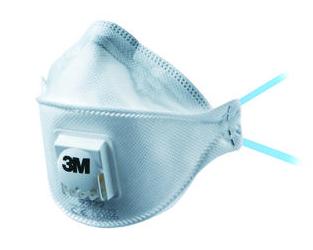
Above – single use disposable P2 mask
The following masks may be reused, however as soon as the mask becomes wet it must be disposed of. If you are reusing these masks, they must be stored in a sealed plastic bag between uses and remain in the animal facility. Valve masks tend to be more comfortable and cooler to wear.
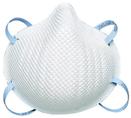
Mask 2200 – disposable with no valve
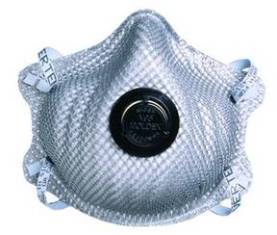
Mask 2400 – this mask also has a charcoal filter to remove odours/fumes if you are using hazardous substances
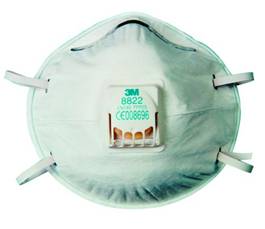
Mask 8822 with valve
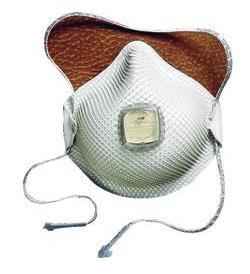
Mask 2700 - valve, cotton with no latex and neck string
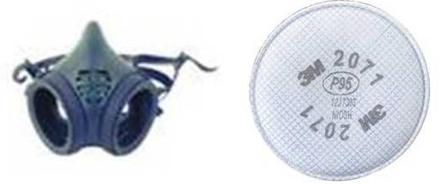
Half face rubber mask (8002) also available in silicon. These masks are fitted with replacement particulate cartridge filters. These masks are much cheaper and it is one per person.
2.2 (vii) Air-fed respirators
Air-fed respirators or positive air pressure respirator (PAPR) may be required to reduce exposure if you suffer from allergies to a species you work with. These respirators supply clean filtered air through a mask to the wearer, eliminating animal allergens to the breathing zone. Such respirators must be trialed and purchased in consultation with the H&S office. These respirators require full fit testing and on-going monitoring.
3. Health surveillance
Health surveillance or monitoring is a part of the minimisation process – as the allergen cannot be completely eliminated from the environment and some exposure is possible then the potential health effects from the exposure must be monitored.
3.1 Identifying those requiring surveillance
All staff and students who will be handling animals or exposed to the animal housing environment are enrolled in the health surveillance programme. All animal related appointments, such as technician staff, are enrolled in the health surveillance programme.
Staff and students identified on Animal Ethics approvals through the Animal Ethics Committees who are required to complete module 1, are automatically notified to Occupational Health and Safety (OHS). OHS will email the health questionnaire to the individual on receipt of the notification, and then follow up with the questionnaire programme.
New staff employed in animal facilities or housing should have the hazard of LAA clearly defined in their job description. Once the appointment has been made, the details of the position and individual are to be forwarded to OHS for enrolment in the health surveillance programme.
3.2 Pre-placement health assessments
Where the position/job description clearly identifies that the position requires monitoring based on the criteria above, then pre-placement assessments will be required. The position descriptions must be sufficiently detailed for people with a pre-existing allergy to make an informed decision on whether to apply.
As it is potentially damaging to the health of people with pre-existing conditions to be exposed to animal allergens, it is a condition of employment that a satisfactory health clearance is obtained by H&S before the individual starts work. This includes the transfer of staff between positions. Please contact the H&S office (extn: 5034) for further information.
3.3 Register of potentially exposed staff and students
It is mandatory for those potentially exposed staff and students to have health surveillance in order to detect the early signs of LAA and take action to reduce the risk of a severe allergic reaction and of long-term respiratory impairment.
Those identified as potentially exposed staff and students will be recorded in a confidential health information system through the H&S office that meets the requirements of the Health Information Privacy Code 1994, and the Privacy Act 1993. All files are held securely with access restricted to the medical staff within the H&S team. Staff and students may request access to their individual records at any time, and access by any other person outside the Medical H&S team will not be permitted without the written consent of the individual.
3.4 Health surveillance programme
The health surveillance system will generate an email for the individuals to complete an on-line health questionnaire. If certain questions or a combination of questions generates a health trigger, the individual and the H&S Team will be notified. At this stage, further health monitoring may be required through a referral to a Respiratory Physician for appropriate testing.
If further monitoring identifies asthma type reactions, a report will be forwarded to the individual, and to the H&S team. If the H&S team is required to notify your employer, manager or PI of your fitness to work, this will be completed with your approval and to the consent guidelines. No personal medical information will be disclosed without signed consent from the individual concerned.
If the results demonstrate an allergy to laboratory animals, the OHS team may advise that you are removed from working with animals until test results are available, and full assessment has been made. With mild cases of sensitivity, it is possible to maintain individuals in their work with suitable personal protective equipment. Where this is not possible, suitable redeployment may be required.
3.5 Diagnosed cases of LAA
Where LAA is diagnosed, the ACC processes of determining a work related illness will be initiated. The decision on the claim and entitlements will follow the ACC policies and procedures. Staying at work or returning to work will be managed by the ACC Case Management team.
Related policies, procedures and forms
- Health and Safety Policy
- Laboratory Animal Allergy and Zoonosis Prevention Policy
- The Tertiary and International Learners Code of Practice
Contact for further information
If you have any queries regarding the content of this policy or need further clarification, contact:
Director, Health, Safety and Wellbeing
Email hsa@otago.ac.nz